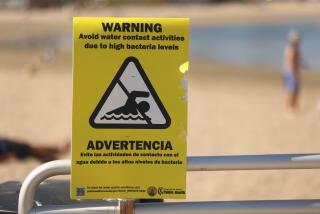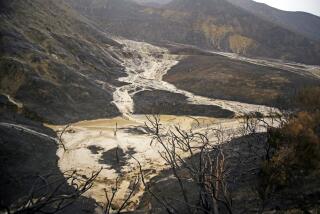Southern California beach erosion is worst in a decade
Jeremy and Fernando Gutierrez descended a staircase to a cove in Laguna Beach for a nighttime lobster dive and almost fell into the ocean.
Even in the darkness, the brothers could see what the problem was -- the sand at Treasure Island Beach had all but disappeared, leaving a rugged landscape of rock and a sudden drop-off where the staircase once led gently to the strand.
“I couldn’t believe it,” said Fernando Gutierrez, 26, of Costa Mesa. “There was no beach and a 20-foot drop-off.”
It’s a similar scene at dozens of other Southern California beaches where powerful winter storms have swept away a spectacular amount of sand.
The vanishing beaches have forced city crews in Dana Point to remove fire rings, picnic tables and shower pads so lifeguards have room to patrol the remaining sand.
At Laguna’s Rockpile Beach, the waves scrubbed the shore so heavily that jagged rocks and rusty remnants of an old sewer system that haven’t been seen for years reemerged.
“This year it was just plain rock pile,” said Ken Frank, city manager of Laguna Beach. “Forget the beach.”
And at Dockweiler Beach near Los Angeles International Airport, cobblestones are visible where there once was soft sand, and workers have been using heavy machinery to fill in some of the more perilous drop-offs.
“We lost half a dozen palm trees that were planted in the 1980s” after the sand holding their roots washed away, said Rich Haydon, the state Department of Parks and Recreation superintendent for Doheny, San Clemente and San Onofre state beaches. “The amount of sand taken away from Doheny is going to take many, many years to replenish, if it does replenish at all.”
The storms’ scouring of the Southern California shoreline -- remarkable at some beaches, barely noticeable at others -- has caused the worst damage and most significant beach erosion in at least a decade, according to parks and beach officials.
In January and February, powerful swells, high tides and strong winds swept away tons of sand from the coastline, stealing as much as 30 to 40 feet of beachfront at some locations.
In the month or two since the El Niño-driven storms, coastal communities -- Laguna Beach, Malibu and Manhattan Beach among them -- have worked to patch the damage by making repairs and trucking in fresh sand, but some worry whether nature will return the sand as it has in the past.
The sand loss is a familiar phenomenon.
Shifting sand is part of a natural cycle that happens each year. Each spring, potent storm surges pull sand from the beaches out to sea. Over the summer, gentler waves gradually push it back ashore.
Periodically, beach cities throughout Southern California try to make up for the so-called sand deficit by pumping the material in from offshore.
Global warming and sea rise are contributing to the deterioration of beaches in the long term, scientists say, but those forces are not to blame for this spring’s dramatic changes.
It’s the exceptional level of damage this year that has been cause for alarm.
“This is the worst I’ve ever seen it as far as erosion and the deficit of sand along our coast,” said Joanette Willert, a supervising park ranger for Orange County’s parks department and a 24-year veteran. “It seems like every storm just took, took, took and none of our sand returned.”
In the Peninsula area of Long Beach, where storm-whipped waves consumed sand voraciously, workers have been trucking sand deposited in a parking lot to amass an 80-foot buffer between the ocean and homes, according to a city report.
At beaches like El Porto on the northern end of Manhattan Beach, the storms have eaten away at the underwater surfaces too, causing turbulent waters that could pose a hazard when beaches begin to fill up with tourists.
“The topography of our beach is completely uneven everywhere,” said Los Angeles County Lifeguard Capt. Terry Harvey.
He said the erosion “created unbelievable holes, trenches and rip currents.”
Some ocean watchers, however, keep faith in the ocean’s ability to resupply the sand.
“More sand got removed this winter, but that means there’s more sand to pile back up on the beach in the summer, which nature will do,” said Ballona Institute co-director Roy van de Hoek.
At the tony Montage resort in Laguna Beach, where workers had built an emergency wooden stairway after guests complained that an existing staircase now ended eight feet above the shoreline, the sand is starting to build up again.
Other factors, however, make the slow homecoming of the sand less reliable than it used to be.
Sea walls and jetties have impeded the distribution of sand along the coast, making it harder for it to resettle after the tumult of spring storms.
And rivers that once deposited sand on the shore near mouths are now mostly paved. Dams upstream keep sediment inland.
Even sand replenishment projects are susceptible to the destructive powers of Pacific waves.
In one dramatic example, workers spent weeks last year dredging a harbor and pumping masses of sand to Capistrano Beach to keep it from becoming too narrow to use.
“It looked great right after it was done,” Willert said.
After the year’s first storm, however, the sand had vanished.
More to Read
Sign up for Essential California
The most important California stories and recommendations in your inbox every morning.
You may occasionally receive promotional content from the Los Angeles Times.











